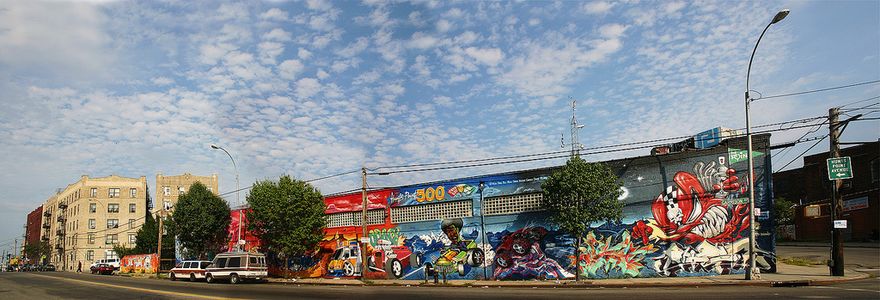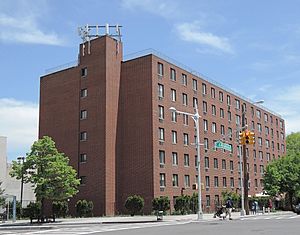Hunts Point, Bronx facts for kids
Quick facts for kids
Hunts Point
|
|
|---|---|
|
Neighborhood of the Bronx
|
|
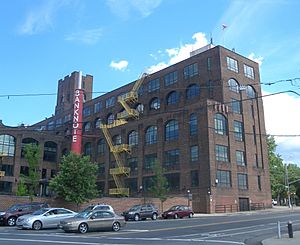
The American Bank Note Company Printing Plant in Hunts Point
|
|
| Country | |
| State | |
| City | |
| Borough | |
| Community District | Bronx 2 |
| Founded | 1849 |
| Named for | Thomas Hunt |
| Area | |
| • Total | 4.27 km2 (1.650 sq mi) |
| Population
(2010)
|
|
| • Total | 12,281 |
| • Density | 2,873.8/km2 (7,443.0/sq mi) |
| Economics | |
| • Median income | $25,678 |
| Ethnicity | |
| • Hispanic | 74.6% |
| • Black | 22.2% |
| • White | 1.3% |
| • Asian | 0.7% |
| • Others | 1.2% |
| ZIP Code |
10474
|
| Area code | 718, 347, 929, and 917 |
Hunts Point is a neighborhood in the South Bronx area of New York City. It sits on a piece of land surrounded by water, called a peninsula. Hunts Point is famous for having one of the biggest food distribution centers in the world.
The neighborhood is bordered by the Bruckner Expressway to the west and north, the Bronx River to the east, and the East River to the south. Hunts Point Avenue is the main street that runs through the area. Hunts Point is part of Bronx Community District 2, and its ZIP Code is 10474. The local police station is the 41st Precinct of the New York City Police Department.
Contents
Discover Hunts Point's Past
Early European Settlers
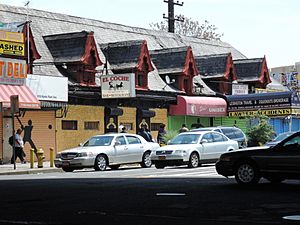
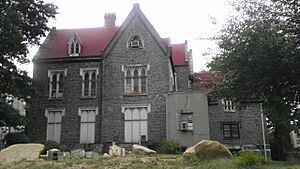
Before European settlers arrived, the Wecquaesgeek people, who spoke the Munsee language, lived in Hunts Point. In 1663, English settlers Edward Jessup and John Richardson bought the land from them. After Jessup passed away, his wife, Elizabeth, gave the land to her son-in-law, Thomas Hunt Jr. The area was named after him.
Over the years, other wealthy families owned land on the peninsula. One story says that George Fox (1624–1691), who started the Society of Friends (also known as Quakers), preached here in 1672. His descendant, William H. Fox, and his wife Charlotte Leggett, owned a large part of what is now Hunts Point.
From Estates to Apartments
Between 1850 and 1900, more people from New York City started moving to Hunts Point. Later, the land was owned by H. D. Tiffany, who was part of the family that owned the famous Tiffany & Co. jewelry store. Today, Fox, Tiffany, and Leggett Streets are named after these early landowners. The Fox family mansion was taken down in 1909.
After World War I, Hunts Point changed from a place for wealthy families to a more diverse neighborhood. The IRT Pelham Line subway was built, and apartment buildings began to replace large mansions. Hunts Point became a home for many different people from the city.
Growing into an Industrial Hub
The 20th century also brought a lot of industry to Hunts Point. Businesses realized that the area was a great location because it was easy to reach from different states. It also had existing train lines and plenty of space for new businesses.
This led to many companies moving in. Hunts Point became known as a good place for business. The New York City Produce Market opened in 1967, and the Hunts Point Meat Market opened in 1974. In 1980, Hunts Point was officially named an Industrial Park. Today, the Hunts Point Industrial Park has over 800 businesses that provide products and services around the world.
However, the second half of the 20th century was a tough time for the people living in Hunts Point. Many residents left the neighborhood during the 1970s because of difficult living conditions. Things started to improve later, and the first full-service post office opened in 2001.
Who Lives in Hunts Point?
Hunts Point is home to about 8,684 people. It is a neighborhood where many Puerto Ricans live, along with African Americans, Dominicans, Mexicans, and other Latin American groups. In fact, Hunts Point has one of the highest numbers of Hispanic residents in New York City.
According to the 2010 United States Census, the total population of Hunts Point and Longwood was 27,204. Most residents are young people and middle-aged adults. About 28% are under 18, 29% are between 25 and 44, and 21% are between 45 and 64.
Land and Green Spaces
Hunts Point is a peninsula where the Bronx River meets the East River. The East River is actually a tidal strait that connects Upper New York Bay to the Long Island Sound. The total land area is about 690 acres (2.8 square kilometers).
Most of the land in Hunts Point is used for industry. There is a smaller area where people live, mostly in older pre-war architecture apartment buildings and some row houses. This residential area is on higher ground in the northern part of the peninsula.
In 2004, the New York City Department of City Planning created a Special Hunts Point District. This plan helps the food distribution center grow while also protecting the residential neighborhood.
Parks and Recreation
Hunts Point Riverside Park was started by Majora Carter in 2000. It has won awards for being an excellent public space.
Joseph Rodman Drake Park is also in Hunts Point. It is known as a burial ground for enslaved African-Americans.
The biggest park in Hunts Point is Barretto Point Park, which is 5 acres (2 hectares) large. It's located on the East River waterfront. Here, you can fish from piers, launch canoes and kayaks, and even use a floating swimming pool in the summer. The park also has volleyball and basketball courts, a small amphitheater, and restrooms.
Hunts Point Food Distribution Center
Hunts Point is home to one of the largest food distribution centers in the world, covering 329 acres (1.33 square kilometers). The Produce and Meat Distribution Centers opened along the Bronx River in 1967 and 1974. In 2005, New York City's New Fulton Fish Market moved here, replacing the old market in Manhattan.
More than 800 businesses operate on the peninsula, employing over 25,000 workers. Many of these are food wholesalers, distributors, and food processing companies.
Here are some of the facilities that make up this huge food hub:
- The New York City Terminal Market sells fresh fruits and vegetables from all over the United States and many other countries. It has four large buildings, each about a third of a mile long. Over 65 fruit and vegetable wholesalers run this market. They sell about 2.7 billion pounds of produce each year!
- The Hunts Point Cooperative Market handles meat, poultry, and related products. It covers 38 acres (15 hectares) and has six main buildings with 700,000 square feet (65,000 square meters) of refrigerated space. More than 50 independent wholesale food companies work here.
- The new Fulton Fish Market building opened in 2005. This 450,000-square-foot (42,000-square-meter) complex allows seafood distributors to store their products in a temperature-controlled warehouse. It makes it easy to deliver seafood to New York City, New Jersey, and Connecticut.
Detention Centers
The Spofford Juvenile Center was once a place for young people who needed secure detention. It opened in Hunts Point in 1957. The center was later renamed Bridges Juvenile Center in 1999. In 2011, Bridges was closed by the city. The building was torn down in 2019 to make way for new housing.
The Vernon C. Bain Correctional Center (VCBC) is a unique 800-bed facility located on a barge offshore of Hunts Point. It is part of the New York City Department of Corrections and opened in 1992. It is named after Vernon C. Bain, a warden.
Public Housing
Hunts Point has one New York City Housing Authority low-income housing development called Hunts Point Avenue Rehab. It includes thirteen buildings that are 4 or 5 stories tall.
Community Organizations
Many non-profit organizations work in Hunts Point to help the community. Some of these include the Hunts Point Economic Development Corporation (HPEDC), Sustainable South Bronx (SSBx), THE POINT Community Development Corporation, Rocking the Boat, and the Hunts Point Alliance for Children.
- The Hunts Point Economic Development Corporation (HPEDC) was started in 1988 to help businesses in Hunts Point. They have worked to bring in new projects and jobs, like helping the Fulton Fish Market move to Hunts Point.
- Rocking the Boat teaches young people how to build traditional wooden boats and learn on the water. This helps them grow into responsible adults. They have programs throughout the year and hold community rowing events.
- Sustainable South Bronx (SSBx) is an environmental group that has helped build two new waterfront parks along the Bronx River and East River. They also run a training program called Bronx Environmental Stewardship Training (BEST) to teach local residents skills related to managing their environment.
- The Hunts Point Alliance for Children (HPAC) works with families, schools, and other non-profits to support the education of children in Hunts Point. They offer programs in early childhood education, youth development, and academic support.
- The POINT Community Development Corporation is a non-profit that focuses on youth development, culture, and improving the economy in Hunts Point. They offer space for arts, galleries, and after-school programs for kids.
Arts and Media
Hunts Point has a growing arts scene. Places like THE POINT Community Development Corporation and the Bronx Academy of Arts and Dance (BAAD) offer performance spaces and art galleries. THE POINT, located in an old bagel factory, also provides after-school arts programs for children.
Since 2006, an online news outlet called The Hunts Point Express has reported on news in Hunts Point and Longwood. It is written by students from the Craig Newmark Graduate School of Journalism.
Staying Safe
Hunts Point has its own New York City Fire Department (FDNY) fire station, Engine Co. 94/Ladder Co. 48/Battalion 3, located at 1226 Seneca Avenue.
Health in the Community
The air in Hunts Point and Longwood has more tiny particles (a type of air pollution) than the city average. About 15% of residents are smokers. Also, 42% of residents are obese, 20% have diabetes, and 38% have high blood pressure. These numbers are higher than the city averages.
About 82% of residents eat some fruits and vegetables every day, which is a bit less than the city's average. For every supermarket in Hunts Point and Longwood, there are 20 bodegas. The closest hospital is NYC Health + Hospitals/Lincoln in Melrose.
Post Office and ZIP Code
Hunts Point uses the ZIP Code 10474. The United States Postal Service operates the Hunts Point Station at 800 Manida Street.
Learning and Schools
Hunts Point and Longwood generally have fewer residents with a college education compared to the rest of New York City. About 16% of adults aged 25 and older have a college degree or higher.
The percentage of elementary school students who miss many days of school is higher in Hunts Point and Longwood than the city average. About 35% of elementary students miss twenty or more days each school year. Also, 58% of high school students in Hunts Point and Longwood graduate on time, which is lower than the city average of 75%.
Local Schools
Several schools are located in Hunts Point, including the Bronx Charter School for the Arts, the Bronx Lighthouse Charter School, Hyde Leadership Charter School, and the South Bronx Classical Charter School. In September 2011, Hyde Leadership Charter School opened on Hunts Point Avenue. It was the first college preparatory high school to open in Hunts Point in almost 30 years.
Other schools include the John V. Lindsay Wildcat Academy Charter School, MS 424 (formerly MS201), PS 352, PS 48 Joseph R Drake, St. Ignatius School, and Wildcat Second Opportunity School. IS 217, the School of Performing Arts, is also in Hunts Point.
Community Library
The New York Public Library has a branch in Hunts Point, located at 877 Southern Boulevard. This library, known as the Hunts Point branch, was designed in the Italian Renaissance style and opened in 1929. It was the last Carnegie library built for the New York Public Library system and is a New York City designated landmark.
Getting Around Hunts Point
You can get to Hunts Point using the New York City Subway and bus lines.
Subway Stations
The following subway stations serve Hunts Point on the IRT Pelham Line:
- Longwood Avenue (6 train)
- Hunts Point Avenue (6 <6> trains)
- Whitlock Avenue (6 train)
Bus Routes
The following bus routes serve Hunts Point:
- Bx5 to Co-op City and Bay Plaza Shopping Center
- Bx6 and Bx6 Select Bus Service to Washington Heights or Hunts Point Cooperative Market
- Bx46 to Longwood or Hunts Point Cooperative Market


